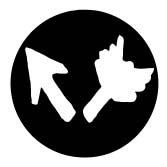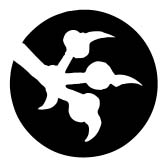



-2 Atk
| Max Threat: | Terrifying |  |
 |
 |
 |
| Benchmark: | 25 | ||||
| Adjusts: |
-2 Atk |
-5 Def | +3 Soak | +15 Dam | +30 HP |
| Move: | 25 | ||||
| Mix: | 0.4 |
The fire wyrm is a huge, rainbow-hued dragon. It is long and thin, perhaps 20 paces long in adulthood, with a typical wingspan of about 30 paces when its wings are fully extended. It sports six-inch, razor-sharp fangs and equally frightening claws. However, its most fearsome weapon is its ability to breathe a jet of fire. Fire wyrms are cunning and extremely greedy. 25% of them are able to speak (decided upon by the designer, not rolled).
Fire wyrms’ long bodies are easy to hit (DFN -5), and their large relative size makes their attacks against heroes inaccurate (ATK -2). However, their thick, scaly hides soak up a lot of damage (Soak +3) and they can take a lot of punishment (HP +30). If they do manage to hit you, you’re going to regret it (DAM +15).
In order to simulate the fire wyrm’s ability to breathe fire, the designer must add and pay for one or more traps in the combat area.
Fire wyrms typically breathe fire once every three combat actions, starting with its first action (though the designer may choose other triggers, such as a hero tampering with the wyrm’s treasure).
The blast of fire affects one hero (limited targeting). If the encounter notes do not delineate special fire-breathing triggers (such as the aforementioned treasure-tampering), the runner chooses one hero by random roll. The fire breath can have any range, but a maximum of 75 paces is recommended. The fire breath will never affect any character other than the target; it is assumed that any other characters who might be in the line of fire (literally) manage to dodge the blast or otherwise avoid its effects.
The targeted hero must roll Dodge vs. Difficulty 9 to avoid the blast. This does not require a combat action.
If the hero fails to Dodge, he suffers the effects of Raging Fire (see Rune, p. 152). That is, the hero automatically suffers escalating damage starting at 12 points, and must spend a combat action to try to smother the flames (Dex vs. Difficulty 4 + the number of previously failed attempts, unlimited rolls allowed). Dragonfire is also magical: this damage is armor-ignoring.
The wyrm’s use of fire does not cost it a combat action; it may still make a normal melee attack every round it breathes.
Per blast:
Points Spent: 30 (Difficulty 9); 36 (Raging Fire); 10 (armor-ignoring)
Points Earned: -15 (limited targeting, one hero)
Fire wyrms can only breathe fire a certain number of times a day (typically three, though the decision is left to the designer). For each blast available to the wyrm, the designer must pay the full encounter points for the trap. Fire wyrms are best used in a climactic combat event for powerful heroes.
Virtually all fire wyrms possess treasure. The designer can offset the cost for the fire wyrms’ breath by including treasures guarded by the wyrm. For instance, one Category F treasure will more than pay for one blast of fire.
Designers may also balance the cost of dragonfire by placing water sources in the combat are (see Rune, p. 152). If these water sources are used by heroes hit by dragonfire to douse the flames, the runner will earn victory points for a hero-utilized terrain feature.
Although they can fly, a fire wyrm will always spend an entire combat event on the ground. They will not fly during combat. Flying, fighting wyrms are treated as traps (see Flying Wyrms, below). When fighting in the Underground, this is not hard to understand. Designers should be prepared to explain why a wyrm fought outdoors does not fly. Perhaps the wyrm is guarding its nest, or perhaps it has been chained to an enormous boulder by a giant to act as a guard.
The wyrms’ large size makes its body cover more than one hex on the combat map. Runners will have to guess how big the wyrm is based on its combat strength and the description of the fire wrym. This will allow more than four heroes to attack the wyrm in melee simultaneously. The wyrm, however, may attack any opponents adjacent to it, whatever their positions.
Flying wyrms will attack heoes, but such creatures are treated as traps, not foes. Fire wyrms never breathe fire while flying. They tend to singe themselves that way! The designer must pay for a series swoop attacks as per any other trap.
Swoop: The wyrm swoops out of the sky and claws at one hero, then flies up again. The hero attacked is chosen by random die roll.
The targeted hero must roll Dodge vs. Difficulty 6. This does not require a combat action. A failed roll forces the hero to suffer 2d10 damage
The wyrm may swoop once per round (repeat shots, one target per round)
Heroes may stop the swoop attacks by making a successful missile attack against the dragon. This requires a roll of Bows or Thrown Weapon (player’s choice) vs. Difficulty 8. If successful, the weapon has clipped the wyrm’s wing, and it flies off somewhere to land.
If a flying wyrm is encountered during combat, shooting it down requires a combat action.
Points Spent: 7 (2d10 damage); 25 (repeat shots, one target); 20 (Difficulty 8).
If used during combat:
More Points Spent: 10 (combat action
required)
Those wyrms that are able to speak may wish to do so with the heroes. Some ideas for designers to include fire wyrms in their enounters follow.